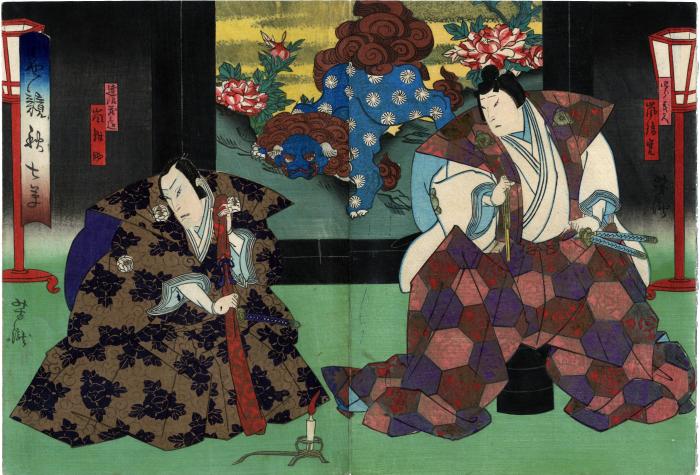Utagawa Yoshitaki (歌川芳滝) (artist 1841 – 1899)
Diptych from the play The Seven Herbs of Iro Kurabe Aki (Iro Kurabe Aki no Nanakusa - 色競秋七草) - Arashi Rikan IV (嵐璃寛) on the right as Shirō Yoshihisa (四郎義久) and Arashi Hinasuke VII (嵐雛助) on the left as Tatsunami Kuranoshin (達浪蔵之進)
08/1867
13.875 in x 9.5 in (Overall dimensions) Japanese woodblock print
Signed: Yoshitaki (芳瀧)
Hankyu Culture Foundation - right panel - figure identified as Amako Shirō Yoshihisa (尼子四郎義久)
Hankyu Culture Foundation - left panel
Lyon Collection - 1848-49 Kuniyoshi print of Amanaka Shikanosuke Yukimori, vassal of Yoshihisa
Japan Arts Council - right-hand panel only In the background is a lion and peony screen.
Maude Rex Allen wrote in 1917 in Japanese Art Motives on page 29: "The peony was brought to Japan in the eighth century from China, where it is one of the plants of the four seasons - the flower of summer. As an art motive, Japan is indebted to Korea for the wonderful variety of adaptation in showing this gorgeous flower."
"Because of the size and beauty of its crimson blossoms, the peony is an emblem of regal power. It is associated with the kara-shishi or Chinese lion - the king of beasts and the king of flowers. Another interpretation of this combination is given:"
In art, the peony is represented among the rocks with kara-shishi, a Chinese association, known as the botanni-kara-shishi, which may illustrate the theory of the survival of the fittest, for it is said that of the cubs which fall to the ground amongst the bushes of the peony, only the strongest succeed in rejoining their mother by climbing the rocks and thus attaining maturity." Allen is citing J. L. Bowes's book, Japanese Pottery on page 495.
****
it is difficult to see, even with the zooming power of enlargement that this site offers, but both actors are wearing clothing covered with one of the Arashi group mon or crests: Rikan IV is displaying in an incredibly subtle way the tachibana or Mandarin orange motif, while Hinasuke VII is covered with the flowering botan or peony motif. [Elsewhere at this site we noted Hinasuke's use of a rabbit crest for a more personal touch.]
****
Illustrated in Ikeda Bunko, Kamigata Yakusha-e Shusei, (Collected Kamigata Actor Prints) volume 5, Ikeda Bunko Library, Osaka, 2005, no. 268.
actor prints (yakusha-e - 役者絵) (genre)
Kyōto-Osaka prints (kamigata-e - 上方絵) (genre)
Arashi Rikan IV (四代目嵐璃寛: from 8/1867 to 5/3/1894) (actor)
Arashi Hinasuke VII (七代目嵐雛助: from February 1873 to April 1875) (actor)
